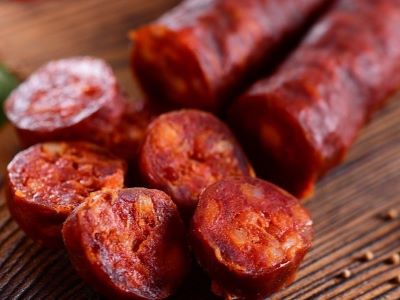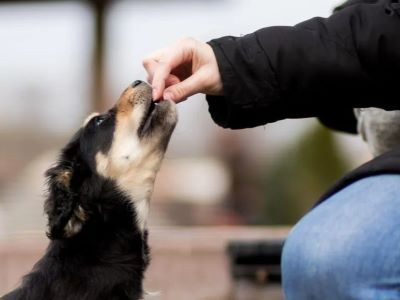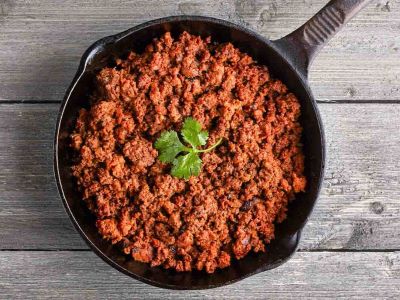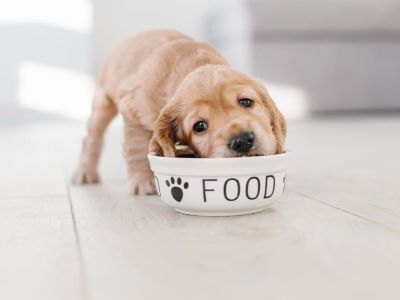Chorizo is a spicy sausage that originated in Spain and Portugal. It’s made from pork and seasoned with paprika, garlic, salt, and other spices. Chorizo is a tasty treat for humans, but is it safe for dogs? Here is a comprehensive look at whether dogs can eat chorizo.

What is Chorizo?
Chorizo is a well-known Spanish and Portuguese pork sausage seasoned with paprika, garlic, salt, and other spices. Originating in the Iberian Peninsula, chorizo has become a staple in Spanish and Portuguese cuisines. Today, many regions worldwide make their versions of chorizo using local ingredients and seasoning preferences. Some examples include Mexican chorizo seasoned with chilli peppers or Argentinian chorizo with added vinegar.[1]

With its deep reddish-hued appearance and smoky, garlicky, and spicy zest, it’s easy to see why chorizo has become such a popular protein worldwide. But is this flavourful sausage something you should share with your canine companion? Let’s dive in and see if dogs can eat chorizo.
Is Chorizo Good For Dogs?

While humans may savour the taste of chorizo, these seasoned sausages aren’t the healthiest choice to feed dogs regularly. Here are some of the main drawbacks of chorizo for dogs to consume[2]:
High Fat and Sodium Content
Chorizo is a high-fat, high-sodium processed meat. The pork, pork fat, oil, and salt used to make chorizo can cause GI upset in dogs if consumed in large quantities. The high calories can also lead to obesity.
Spices and Seasonings
The spices and garlic used to season chorizo may cause stomach irritation in some dogs. Paprika and chilli powder provide much of chorizo’s signature flavour but can be harsh on doggy digestive systems.
Preservations and Casings
Traditional chorizo uses salted, cured meat and natural intestine casings. The salting agents, nitrites, and casings may be difficult for dogs to digest. Artificial casings should also be avoided.
So while the smoky, savoury flavours of chorizo may seem appealing, dogs are usually better off eating blander food choices that are lower in fat, sodium, and harsh spices.
Health Risks of Feeding Chorizo to Dogs

While the occasional small bite of chorizo likely won’t harm an otherwise healthy dog, regular chorizo consumption does pose some health hazards including:
Pancreatitis
The high-fat content in chorizo can trigger a painful, potentially life-threatening inflammation of the pancreas known as pancreatitis in dogs. Dogs prone to pancreatitis should never be given chorizo.
Stomach Issues
Too much chorizo can lead to stomach upset, diarrhoea, vomiting, gas and other GI problems in dogs. The species, sodium, fat, and casings are common culprits.
Sodium and Blood Pressure
Excessive sodium from cured meats like chorizo poses risks of high blood pressure, heart disease, and kidney problems in dogs.
So while the occasional small taste of this seasoned sausage may not cause issues, regular consumption of chorizo can put your dog’s health at risk. Moderation is key.
How Many Chorizos Can Dogs Eat?

No official guidelines for how much chorizo sausage a dog can eat safely. The amount that can be tolerated varies greatly based on a dog’s size and overall health. Some general tips:
- For most dogs, chorizo should only be fed occasionally as a treat in tiny amounts. A few small bites are suitable for larger dogs once or twice a month. Small dogs should get just a tiny taste.
- Do not exceed more than 1-2 tablespoons of chorizo for a large dog, per month. Any more than this may cause stomach upset or pancreatitis. Start with even less for smaller dogs.
- Never feed dogs spicy, salty human food like chorizo regularly as it can lead to health issues over time. It should only be a rare treat.
- Always monitor your dog closely afterwards for any signs of GI upset after eating chorizo. Discontinue use if any negative reaction occurs.
- Ask your vet for specific dosing advice based on your individual dog’s size, health conditions, and sensitivities.
Safer Meat Alternatives for Dogs
If you want to supplement your dog’s diet with additional meat-based protein sources, there are much healthier options than chorizo sausage. Here are some good alternatives:
- Lean Chicken or Turkey: Plain-boiled chicken or turkey breast provides protein without excess fat.
- Fish: Salmon, tuna, sardines, and mackerel are full of omega-3s. Avoid heavy metals.
- Plain Meat: Unseasoned beef, pork, or lamb in moderation can provide protein without spices.
These simpler, blander meat choices make much safer additions than heavily seasoned cured sausages like chorizo.
How to Make Dog-Friendly Homemade Chorizo

If you want to share some homemade chorizo flavours with your pup, there are ways to adjust the traditional spice-heavy recipe to make it more dog-friendly:
- Use leaner cuts of meat, removing excess fat and skin. Ground turkey or chicken works too.
- Substitute dog-safe seasonings like small amounts of ginger, thyme, oregano or rosemary for the paprika and garlic.
- Omit the pork casing. Use cooked ground meat or shape it into sausage patties instead.
- Reduce oil and salt content significantly or avoid them altogether. Use lower sodium meats.
- Add vitamin-rich veggies like shredded carrots or zucchini to improve nutrition.
- Swap a portion of meat for nutritious cooked rice or potato.
These tweaks result in a healthier, dog-appropriate homemade chorizo-inspired recipe without the excess fat, salt and harsh spices. Always start with small portions to ensure tolerance.
Talk to Your Vet Before Feeding Chorizo
While the occasional nibble of chorizo likely won’t harm most dogs, there are some potential health risks involved. It’s best to check with your veterinarian before introducing any new human foods like spicy chorizo sausage to your dog’s diet.
Every dog has unique nutritional needs and health concerns that play a role. Your vet can help you determine if and how to safely incorporate limited amounts of meaty human treats like chorizo as a rare snack. They can also provide tips for avoiding gastrointestinal issues or pancreatitis.
With proper precautions, restraint, and veterinary guidance, the occasional bit of chorizo sausage may be tolerable for some dogs to consume. But for optimal canine health, leaner, blander, and protein sources make the safest regular diet. Be choosy when it comes to giving dogs chorizo!
FAQs
Can dogs eat chorizo?
No, chorizo should only be given to dogs occasionally in tiny amounts. The high fat, salt and spice content can cause health issues if dogs eat chorizo regularly or in large portions.
Can puppies eat chorizo?
No. Puppies should never be given seasoned, fatty human foods like chorizo. Their digestive systems can’t handle it. Wait until dogs are fully grown before offering tiny chorizo bits.
What happens if my dog eats a whole chorizo sausage?
Eating an entire chorizo sausage can cause severe gastrointestinal upset like vomiting, diarrhoea, or even pancreatitis. Contact your vet immediately if your dog consumes a large quantity of chorizo.
Is Mexican chorizo safer for dogs than Spanish chorizo?
Not necessarily. Both Mexican and Spanish chorizo are too high in fat, sodium and spices to be a regular part of a dog’s diet. For occasional treats, Spanish chorizo may be slightly better tolerated.
What part of chorizo can dogs eat?
Remove the casing, then dogs can eat small, lean bite-sized pieces of fully cooked chorizo sausage meat. Avoid giving dogs excessive fat or grease from chorizo.
Conclusion
In conclusion, while chorizo may look like a tasty treat to share with your dog, caution is advised when feeding any seasoned, cured meat. While the occasional small piece is unlikely to harm your dog, chorizo is high in fat, sodium, and spices that can cause stomach upset or pancreatitis if consumed regularly or in large amounts.
For optimal canine health, it’s best to stick to plain, lean meats like chicken, fish, or unseasoned beef. Avoid making chorizo, bacon, or other fatty human foods a staple in your dog’s diet, as the negative effects can compound over time. Check with your veterinarian about any people foods like chorizo that you consider feeding to make sure they are safe for your unique dog.
References:



